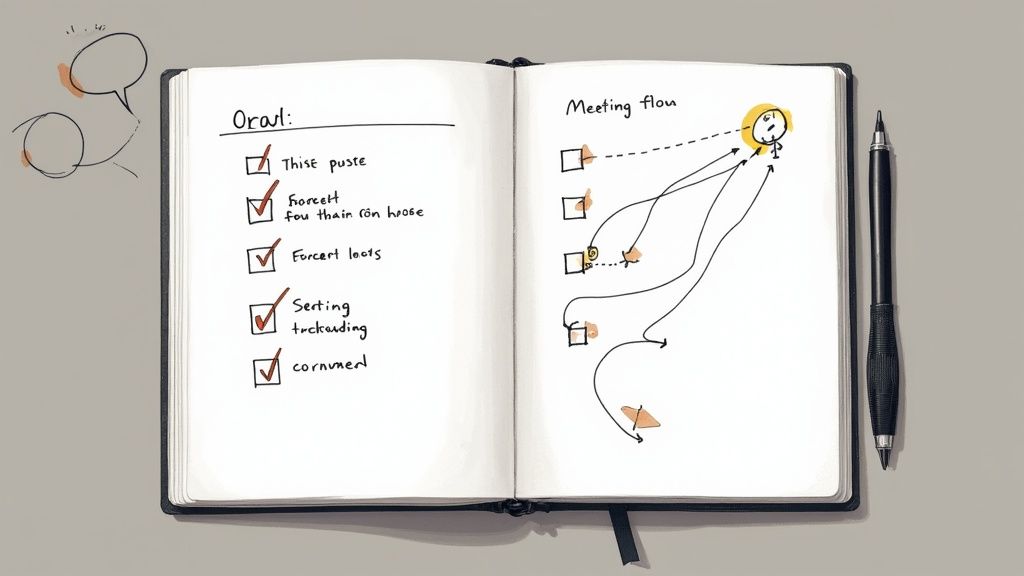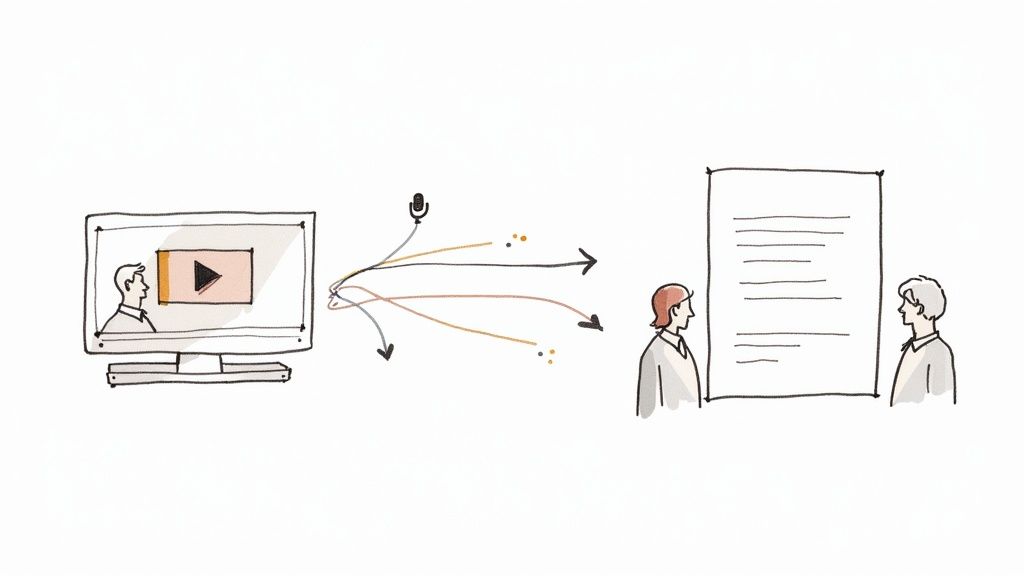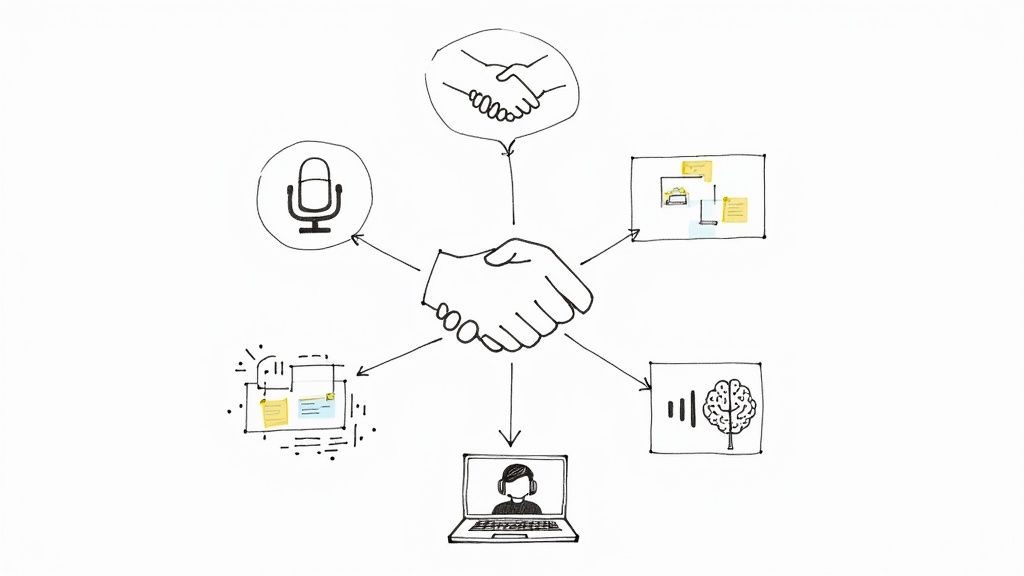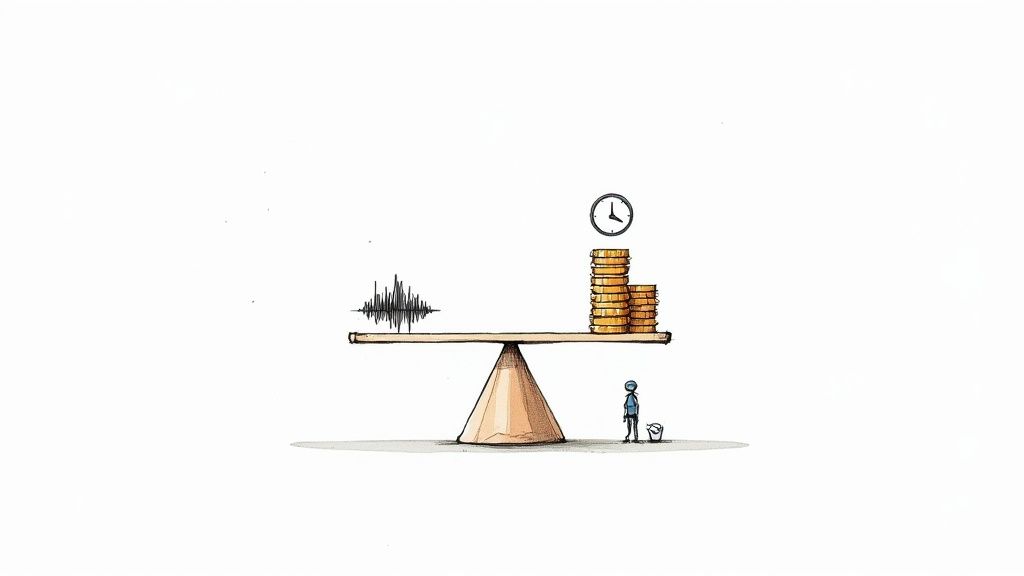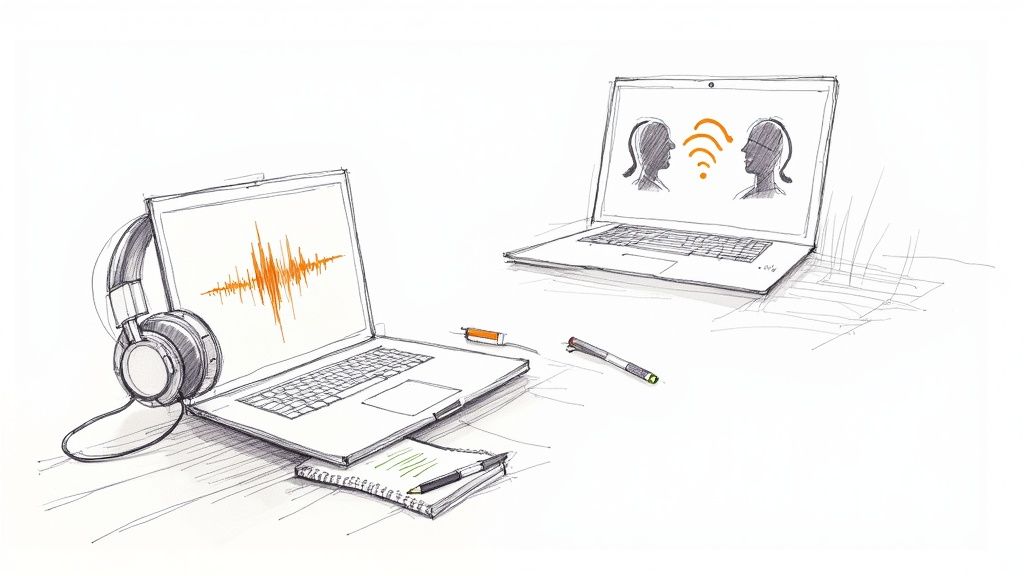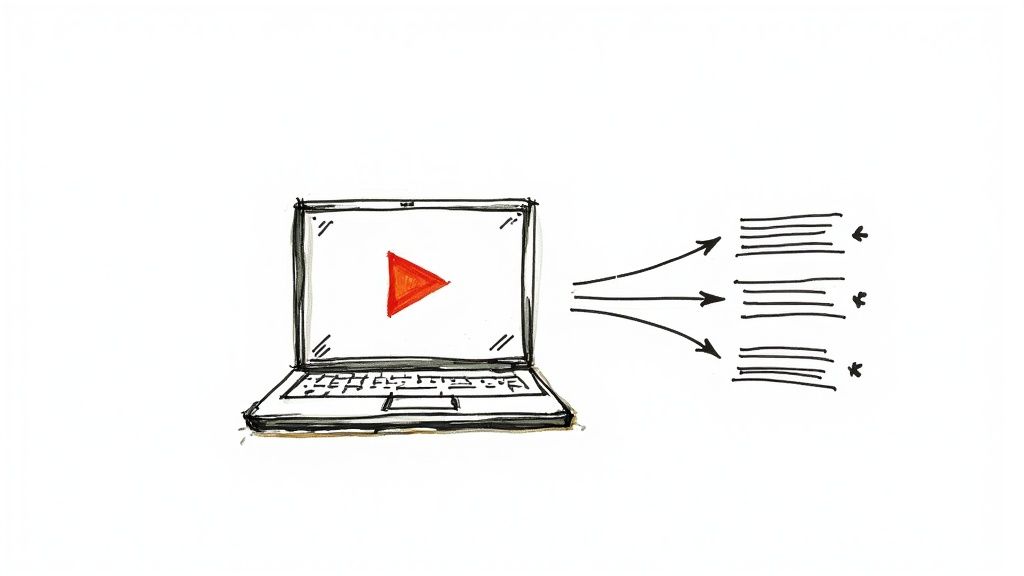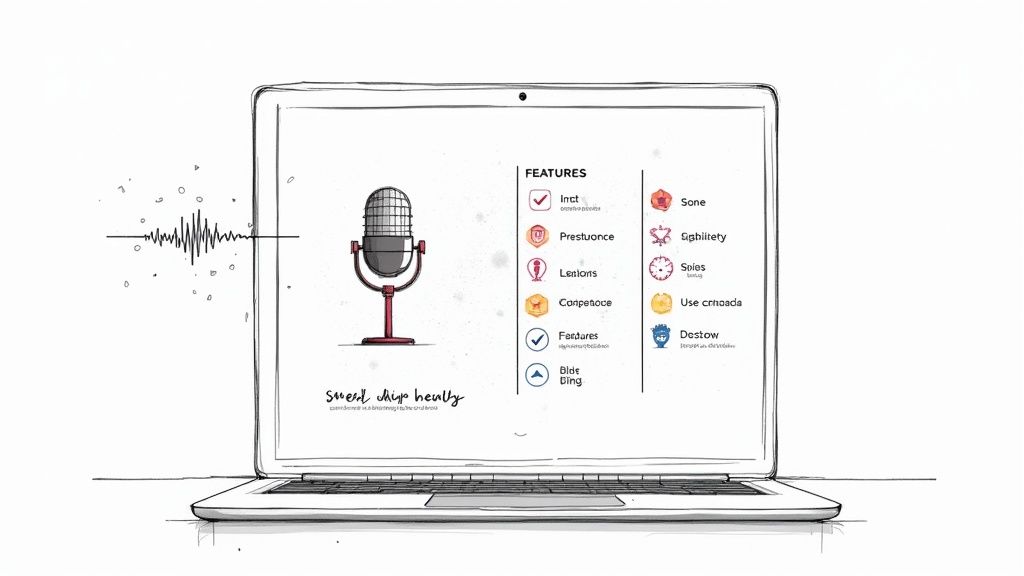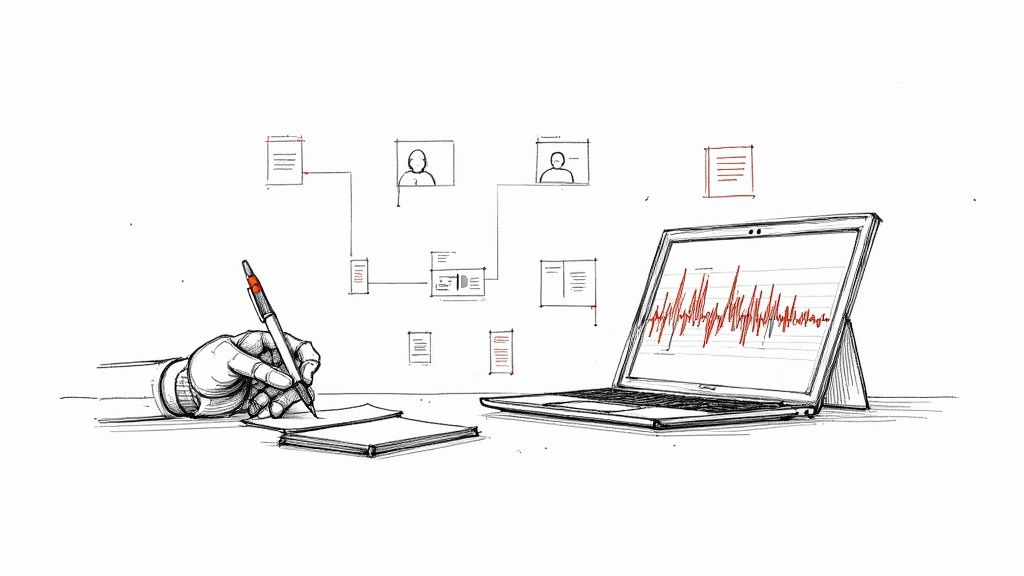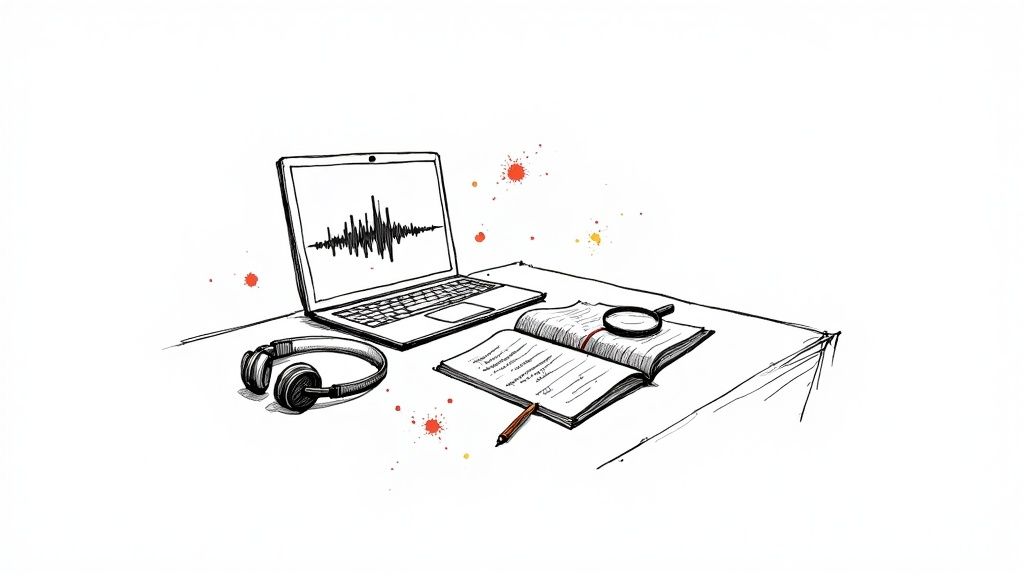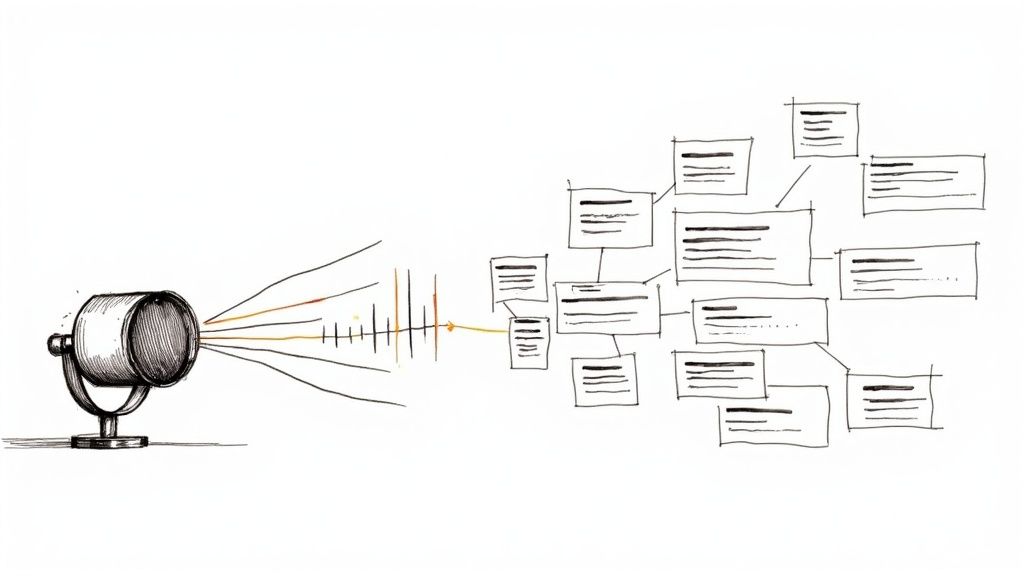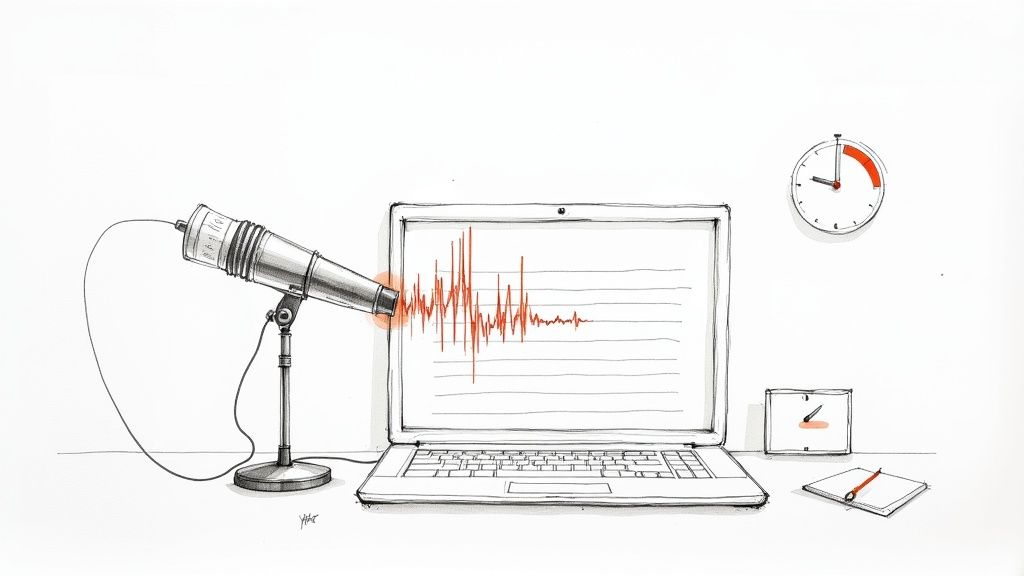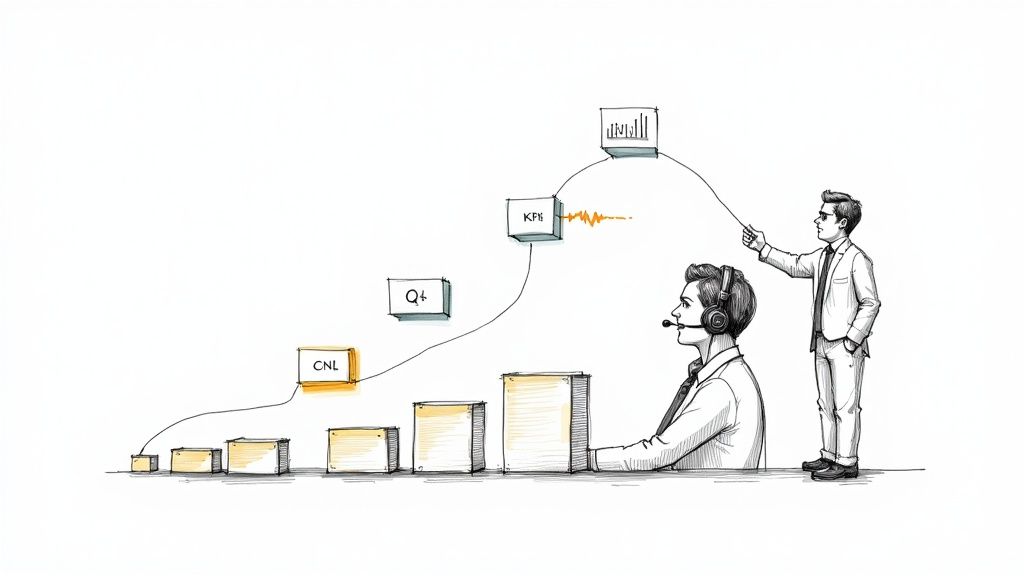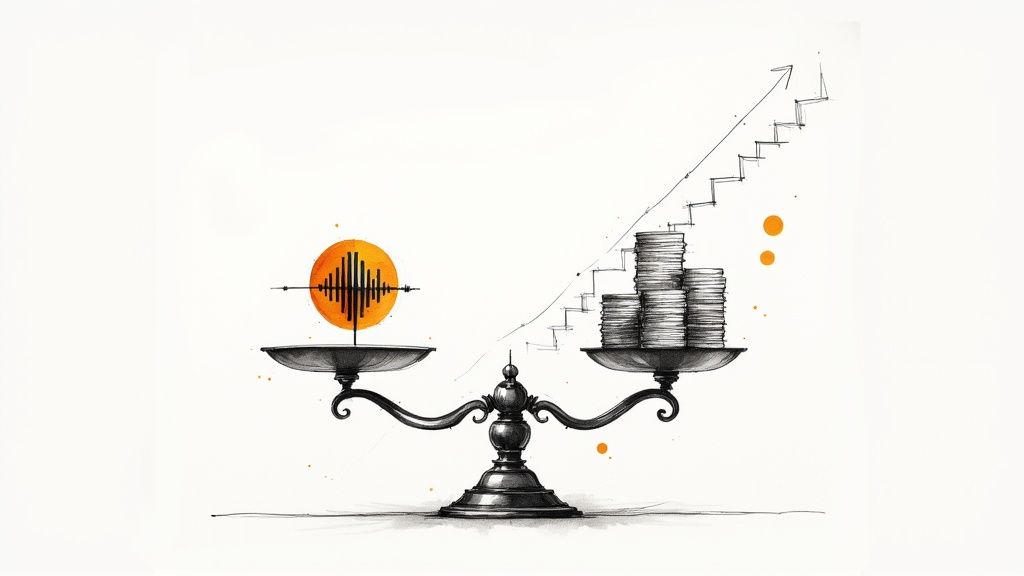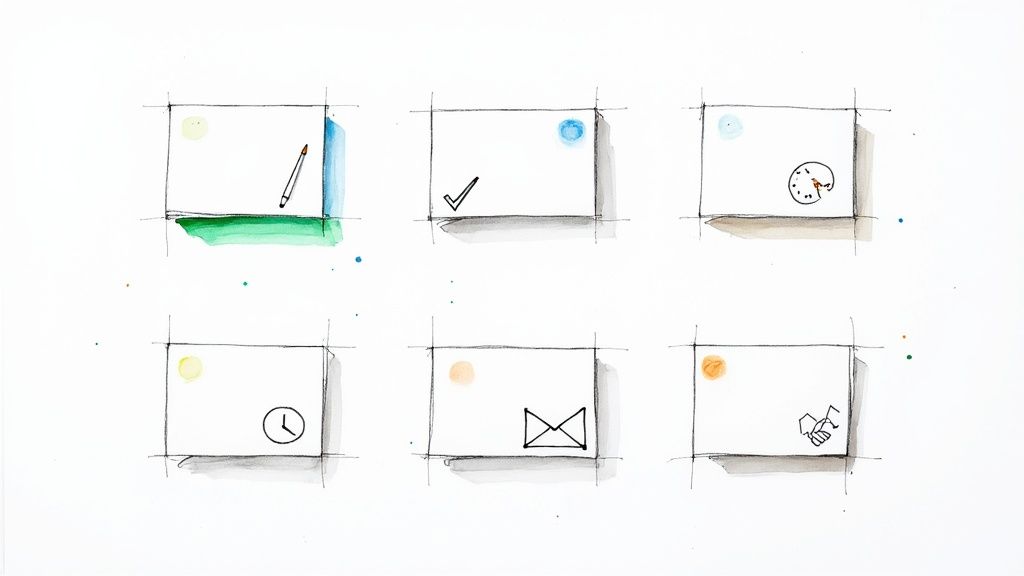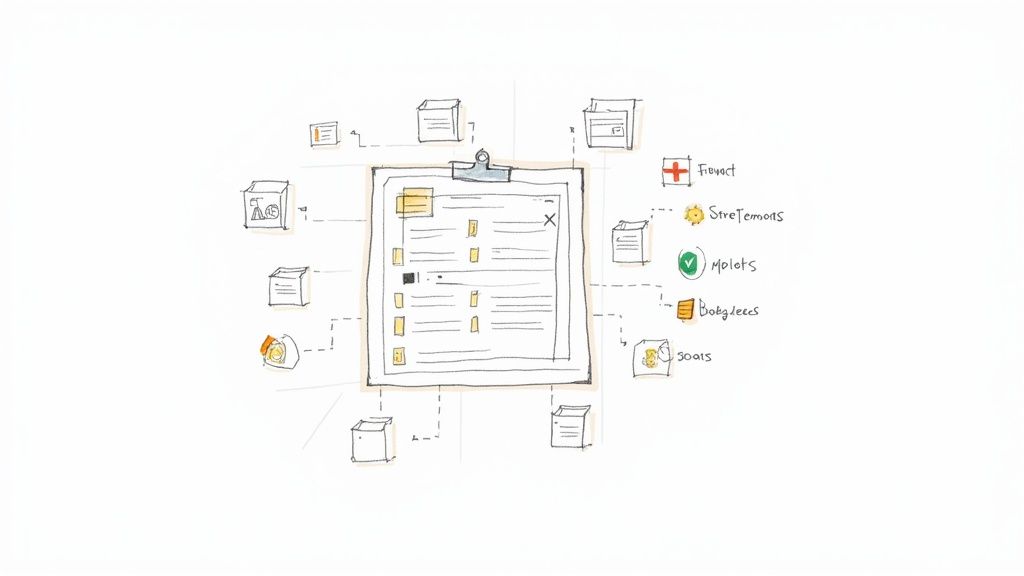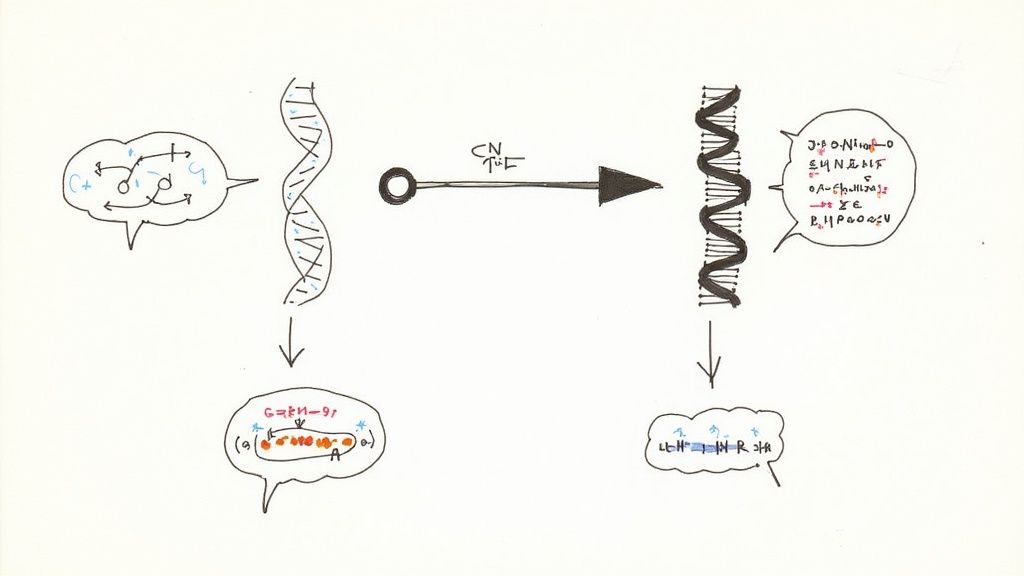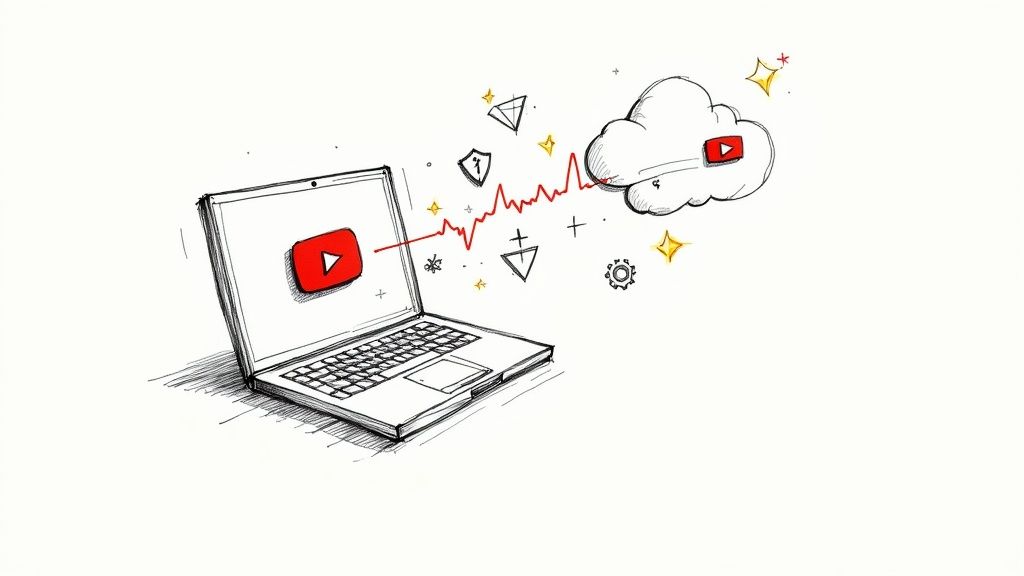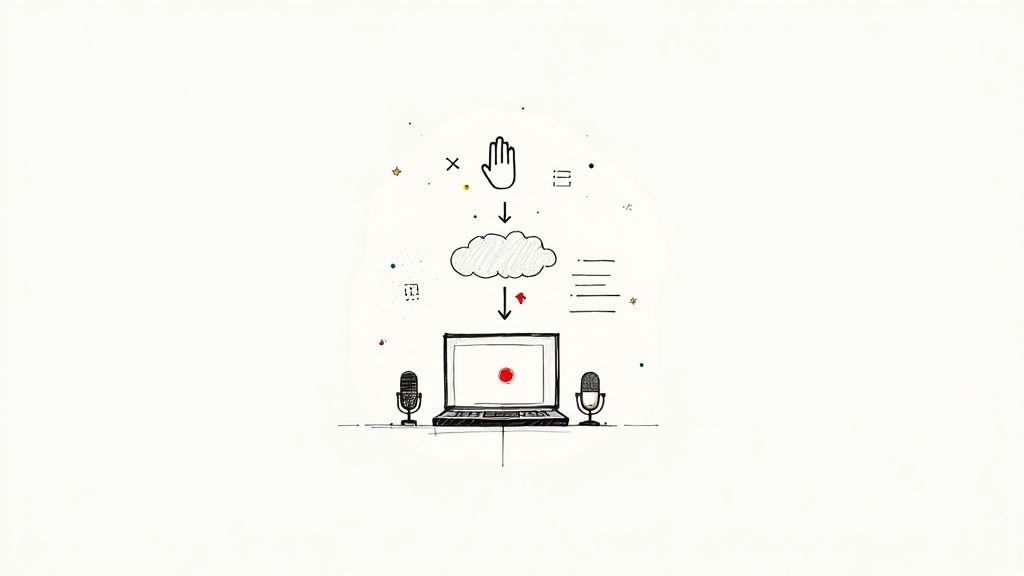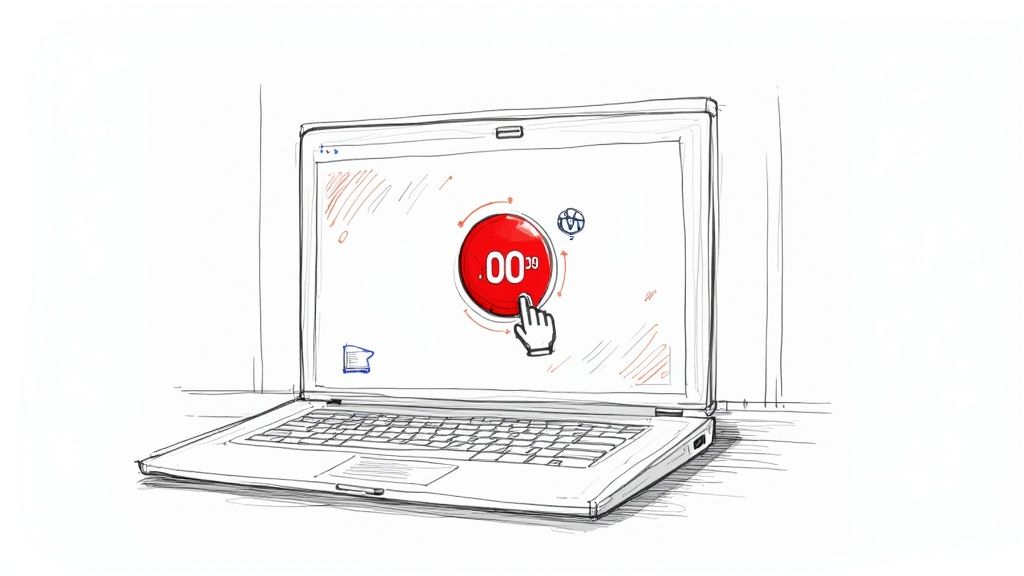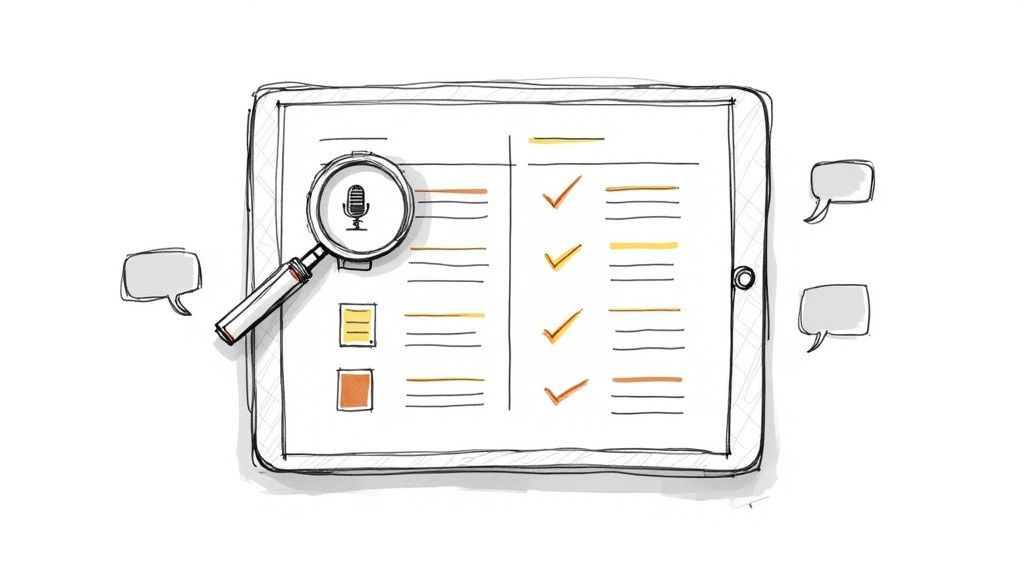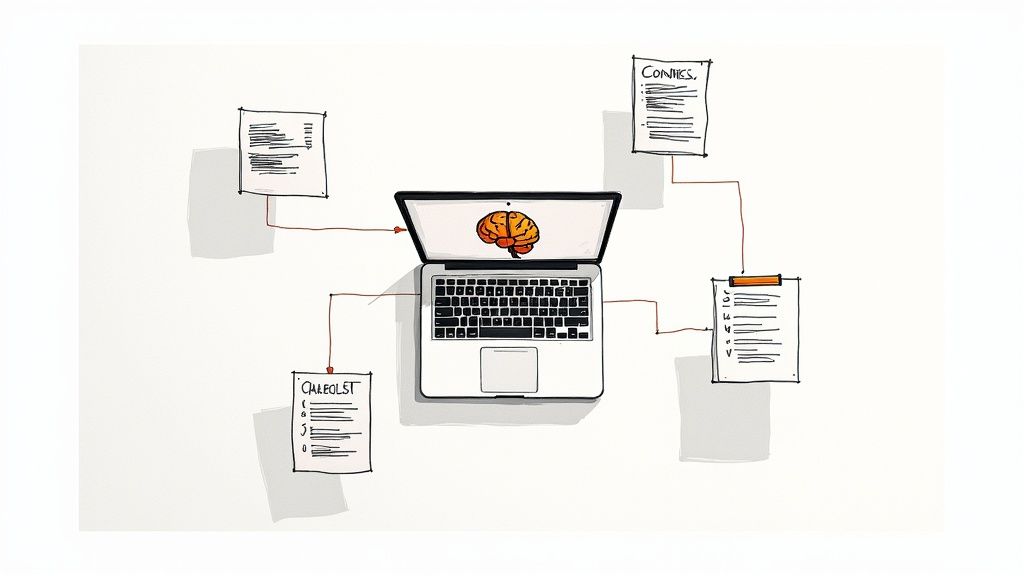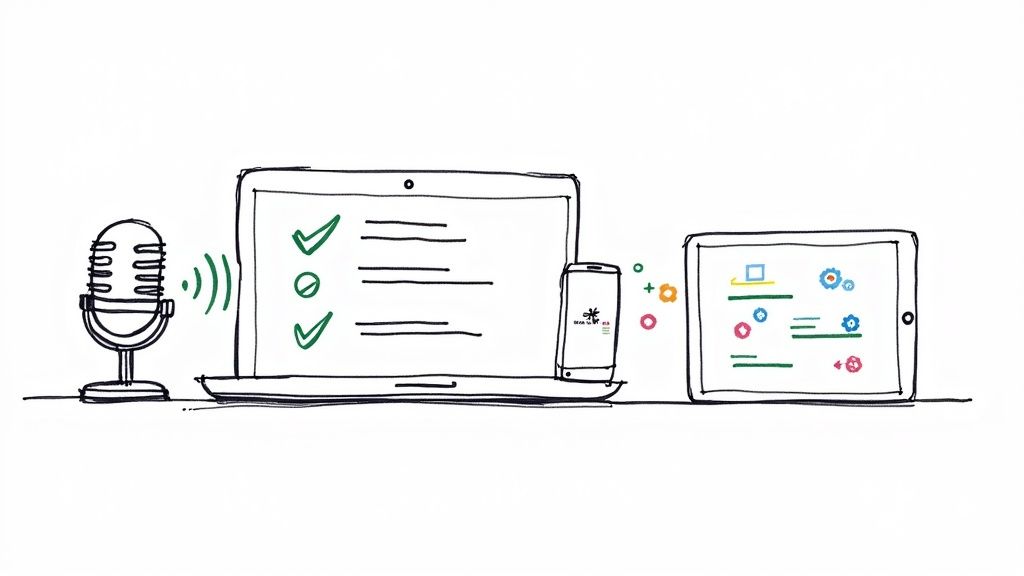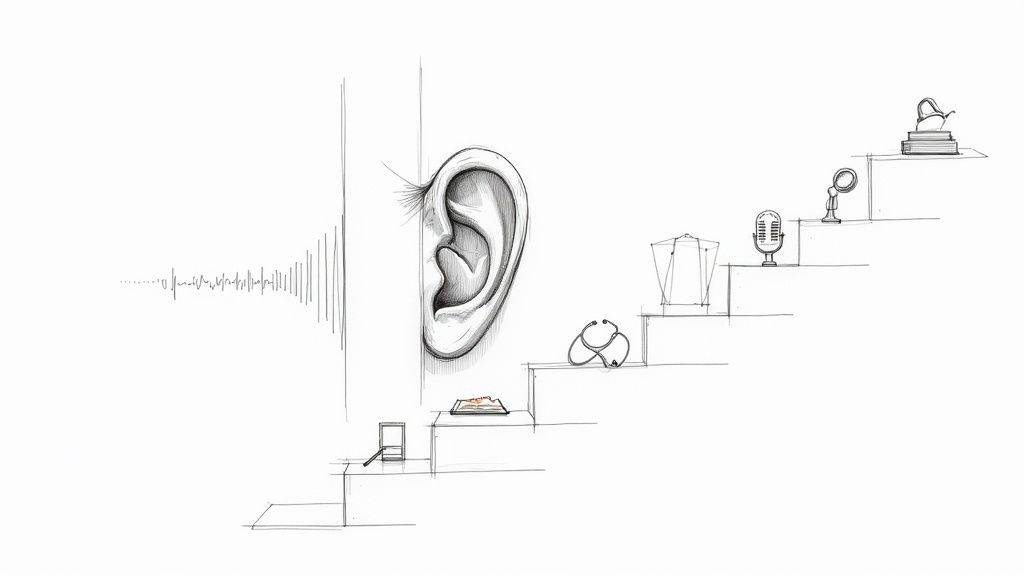Decoding Transcription Service Cost: A 2024 Guide
The cost of a transcription service can swing wildly, from as little as $0.10 to $0.25 per minute for an automated AI service to $1.50 to $5.00 per minute for a professional human transcriber. What you'll actually pay depends on what you need most: the speed and low cost of AI or the near-perfect accuracy a human can deliver for complex audio.
How Much Does Transcription Really Cost?
Let's cut to the chase—what’s the bottom line? Your final cost almost always hinges on one crucial choice: are you using an AI-powered service or a human professional? This decision is the single biggest factor that will influence the transcription service cost.
The infographic below shows the typical price gap between AI and human transcription. It’s a quick way to see just how wide that gap can be.
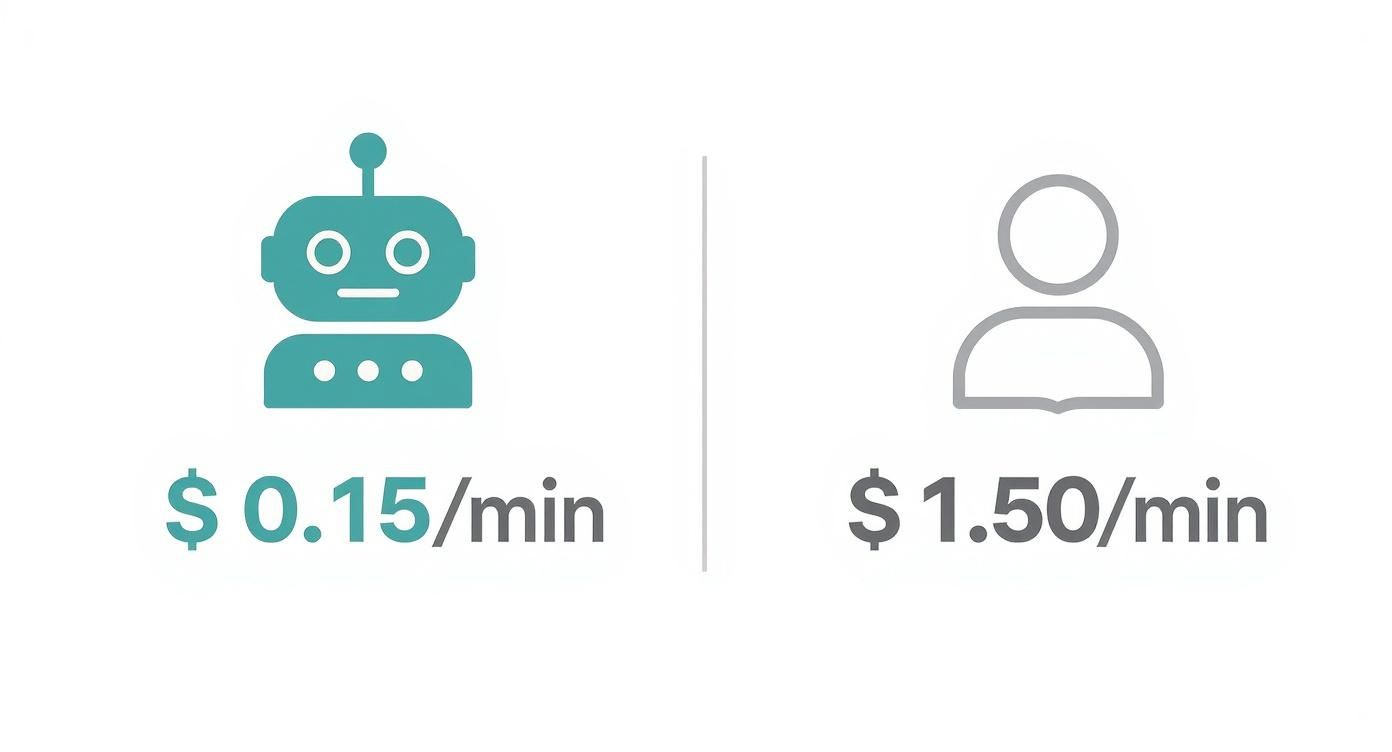
As you can see, human transcription can easily be 10 times more expensive per minute than an AI-generated transcript. Think of this as your starting point. Now, we’ll dive into the "why" behind these numbers and break down all the factors that can affect your final bill.
AI vs. Human: The Core Cost Divide
The cost difference between artificial intelligence and human transcription isn't just a small gap; it's a chasm. AI services typically land in the ballpark of $9-$15 per audio hour, while a human transcriber can run you anywhere from $60-$90 per hour. This massive price difference comes down to completely different ways of working.
Here’s a quick overview of how the two services stack up.
AI vs. Human Transcription at a Glance
Ultimately, this fundamental choice sets the baseline for what you'll pay.
AI Transcription is your best bet when you have clear audio, tight deadlines, and just need a solid first draft. It’s the go-to for students transcribing lectures, podcasters creating show notes, and teams needing quick meeting summaries.
Human Transcription is essential for those mission-critical projects where every word counts. Think legal proceedings, detailed medical records, or nuanced research interviews recorded in a noisy café.
At HypeScribe, our token-based AI system is built for pure efficiency. It can process an hour of audio in under 30 seconds, delivering incredible speed with a cost-effective model. On clear recordings, its accuracy gets surprisingly close to human levels.
The Different Ways Transcription Services Bill You
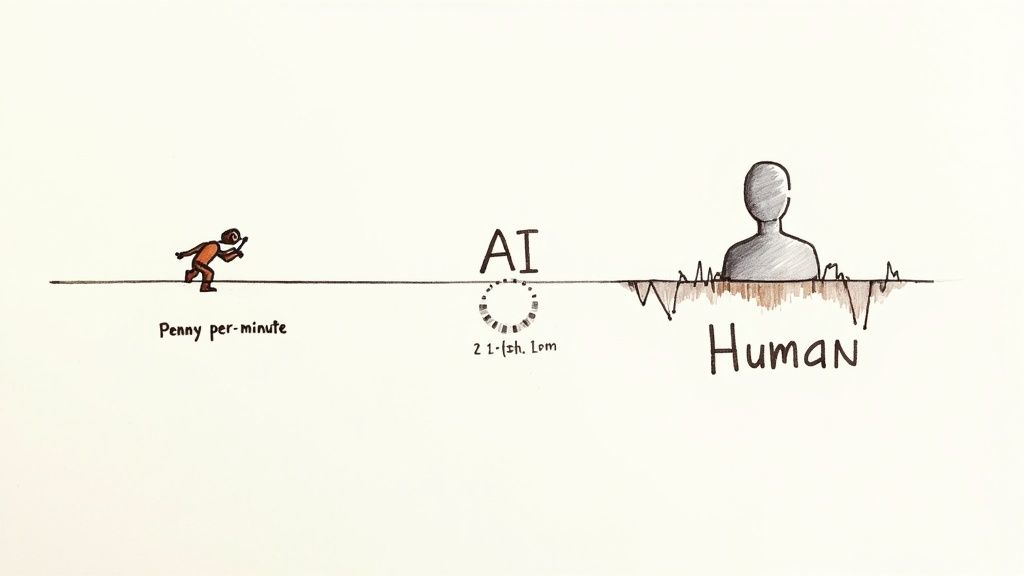
Trying to figure out the transcription service cost can feel a bit like reading a menu in a foreign language. But once you break it down, most services rely on one of three main pricing models. Understanding how they work is the best way to find a plan that fits your budget and avoids any surprises on your bill.
The most common method is per-minute pricing. It’s as simple as it sounds: you pay for the exact length of the audio or video file you need transcribed. Have a 43-minute podcast episode? You'll be billed for precisely 43 minutes.
This approach gives you a ton of flexibility, which is perfect if you only need transcriptions occasionally or if your workload is unpredictable. There’s no monthly commitment, so you only pay for what you actually use.
Pay-As-You-Go vs. Subscriptions
While paying per minute is straightforward, it isn't always the cheapest route, especially if you’re constantly transcribing content. This is where subscription plans come in.
Think of a subscription plan like a gym membership. You pay a set fee each month or year and get a fixed allowance of transcription minutes or hours in return. For example, a plan might offer 600 minutes per month for one flat price.
This model is built for anyone with a steady stream of work—podcasters, marketing teams, and researchers who are transcribing audio week in and week out. The per-minute rate you end up paying is almost always lower than standard pay-as-you-go, making it a great way to save money on consistent usage.
Of course, the flip side is that if your needs are unpredictable—maybe ten hours one month and zero the next—a subscription could mean you're paying for minutes you never use. For sporadic projects, the classic pay-as-you-go model is often a safer bet.
Credit and Token-Based Systems
There’s a third option that strikes a nice balance between a subscription and per-minute rates: the credit-based or token-based system. It works a lot like a prepaid coffee card.
You buy a bundle of credits or tokens upfront, usually getting a better deal the more you buy. Then, you simply use those credits to pay for transcriptions whenever you need them.
Here's how it generally works:
- Buy in Bulk: You might purchase a package of 1,000 credits.
- Redeem as Needed: A 30-minute file could "cost" 30 credits, which are deducted from your balance.
- Flexibility: These credits often have a long expiry date (or none at all), giving you the freedom to use them at your own pace.
This model gives you the cost-saving benefits of buying in bulk without locking you into a monthly fee. At HypeScribe, we use a token-based model because it allows us to process audio at incredible speeds without tying you to rigid time limits, so you get both performance and value. It’s a great fit for teams and individuals who want to be ready for any project without being tied down by a recurring subscription.
What Actually Drives Your Final Transcription Bill
The advertised per-minute rate is just the starting point. The real cost shows up after you add all the features, and with transcription, those "features" can quickly inflate your bill. To manage your budget and get an accurate quote, you need to know what they are.
Your final transcription service cost is shaped, more than anything, by the quality of the audio file you provide. It’s simple: a crystal-clear recording is a breeze to transcribe, so it costs less. A muffled conference call with eight people talking over each other? That's a different story.
The same goes for the number of speakers. A one-on-one interview is pretty straightforward. But a focus group with five people all jumping in? The transcriber has to meticulously untangle who said what, which takes a lot more time and effort.
Audio Quality and Complexity
After you’ve chosen between AI and human transcription, the single biggest factor affecting your bill is the quality of your audio. Bad audio doesn't just mean a few mistakes from an AI—it can also mean hefty surcharges from a human service.
Here’s a quick rundown of the most common audio issues that push prices up:
- Background Noise: Think coffee shop chatter, passing sirens, or even just a loud office hum. Anything that forces the transcriber to guess what was said will cost you.
- Low-Quality Microphones: That built-in mic on your laptop or phone? It’s probably creating a distant, echoey sound that’s tough to decipher.
- Multiple Speakers: Many services will add a surcharge for any file with three or more speakers.
- Heavy Accents or Niche Terminology: If your recording is full of medical, legal, or technical jargon, you’ll need a transcriber with specialized knowledge, and that expertise comes at a premium.
Honestly, one of the best ways to keep your transcription costs in check is to simply use a decent external microphone. It’s a small investment that pays for itself.
Turnaround Time and Special Requirements
Need it yesterday? Just like rush shipping, a faster turnaround time costs more. For a human service, the standard might be a day or two. But if you need that transcript back in a few hours, get ready to pay a premium. That rush fee can easily double the base per-minute rate.
Speed isn't the only extra, though. Any specific formatting you need will also add to the final bill. These are the optional add-ons that customize your transcript but tack on extra fees.
Pay close attention to these add-ons. They’re often where unexpected charges pop up, turning what looked like a cheap service into a surprisingly expensive one. Always check the full list of potential fees before you submit your file.
Two of the most common extras are timestamps and verbatim transcription.
- Timestamps: Need to pinpoint exactly when someone said something? Adding timestamps—like
[00:12:34]—at set intervals or for every speaker change is extra work, and you’ll usually see a per-minute surcharge for it. - Verbatim Transcription: This is the full, unabridged version, and it's the most expensive. A verbatim transcript captures everything: every "um," "ah," stutter, and false start. It’s essential for legal evidence or deep qualitative analysis, but for most projects, it's overkill that will bloat your bill.
Crunching The Numbers: Real-World Cost Examples
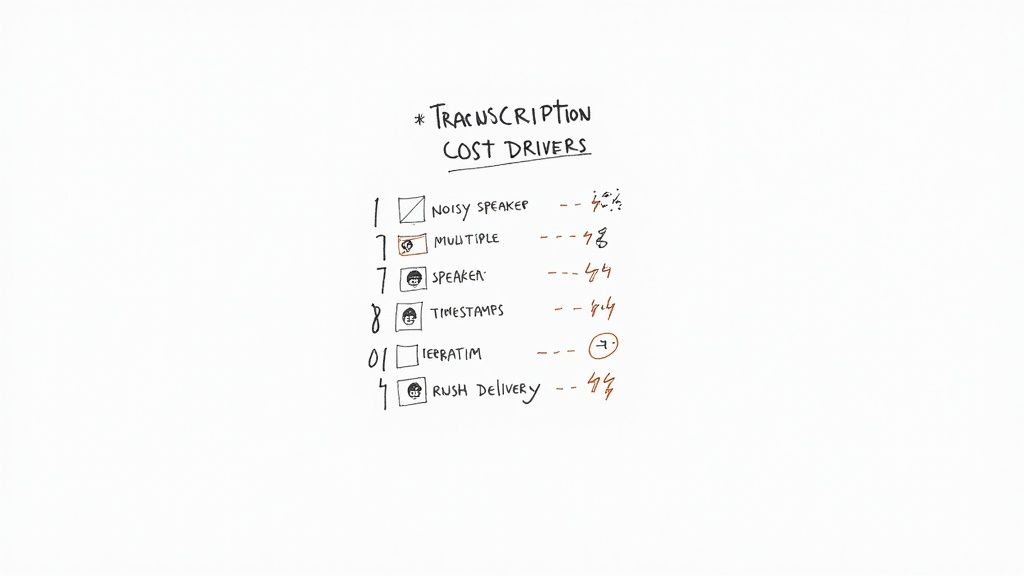
It's one thing to talk about pricing models, but it’s another to see how those numbers stack up in the real world. Let’s walk through a few common scenarios to see how the final invoice changes depending on whether you choose an AI or a human service.
To keep things simple, we'll use some standard industry rates for these examples: around $0.15 per minute for AI and a baseline of $1.25 per minute for a human transcriber.
Scenario 1: The Student’s Lecture Recording
Imagine a college student who needs a 90-minute lecture transcribed for their study notes. The professor’s audio is clear, and 100% perfect accuracy isn’t critical—they just need the key concepts down on paper.
- AI Service: 90 minutes x $0.15/minute = $13.50
- Human Service: 90 minutes x $1.25/minute = $112.50
The difference is staggering. For a student on a tight budget, AI delivers a perfectly usable transcript for the price of a few coffees. It’s the obvious choice here.
Scenario 2: The Journalist on a Tight Deadline
Now, picture a journalist who just wrapped up a crucial 20-minute interview. Their story is due in a few hours, so they need the text back fast. That urgency completely changes the math, especially for human transcription.
Most human services add a hefty rush fee, which can easily be $1.00 or more per minute.
- AI Service: 20 minutes x $0.15/minute = $3.00
- Human Service (with Rush Fee): 20 minutes x ($1.25 + $1.00 rush fee)/minute = $45.00
Even with a pressing deadline, AI provides a near-instant transcript for a fraction of the cost. The journalist can get the text, clean it up quickly, and hit their deadline without blowing their budget. When you're trying to find the best online transcription service, this balance of speed and cost is a huge factor.
Scenario 3: The Marketing Team’s Focus Group
Finally, let’s look at a marketing team with a 60-minute recording from a focus group. There are five different people talking, sometimes over each other, and the audio quality isn't great. They need a super-accurate transcript to analyze every bit of feedback. This is where a human expert really shines.
AI is fantastic, but it can still get tripped up by multiple, overlapping speakers. A professional human transcriber, on the other hand, is trained to pick apart those voices and capture the nuances of a messy conversation. This is one of those times where paying more for human skill really pays off.
- AI Service: 60 minutes x $0.15/minute = $9.00 (but the accuracy would likely suffer)
- Human Service (with multi-speaker fee): 60 minutes x ($1.25 + $0.25 multi-speaker fee)/minute = $90.00
In highly specialized fields, the costs can climb even higher. For example, medical transcription in the US often runs from $1.10 to $3.25 per minute. That higher price tag reflects the need for expert terminology and strict confidentiality.
Cost Estimation For Common Transcription Projects
To make it even clearer, here's a table summarizing how these costs can play out across different projects.
As you can see, the gap between AI and human transcription costs is significant. For straightforward, budget-sensitive tasks, AI is a powerful tool. But for complex, high-stakes projects where accuracy is everything, the investment in a human expert is often well worth it.
Practical Ways to Lower Your Transcription Costs
Knowing what drives up your transcription service cost is one thing, but actually doing something about it is how you keep money in your pocket. You don’t have to just accept the first quote you get. With a few smart moves, you can cut your final bill down significantly without sacrificing the quality you need.
The biggest difference you can make happens before you even hit the record button. Seriously. Improving your audio quality is the single best way to lower your costs. A simple external microphone can work wonders, cutting out the background noise and muffled sound that makes a transcriber’s job—whether human or AI—much harder and more expensive.
Smart Pre-Submission Edits
Here’s another powerful tactic: trim your audio file before you send it off. Most recordings are full of fluff—the chit-chat before a meeting starts, long pauses, or tangents that aren't relevant. Since you’re almost always paying by the minute, chopping out just a few minutes of dead air or off-topic conversation from an hour-long file adds up to real savings.
Beyond editing, think about your timeline. If you’re not in a rush, opting for a longer turnaround time is an easy win. Rush jobs always come with a premium price tag. Planning ahead and choosing a standard delivery window can often save you a hefty 25-50% on the total cost.
One of the smartest, most cost-effective strategies is a hybrid approach. Use a quality AI service for a quick, cheap first draft, and then have a human proofreader clean it up. This gets you near-human accuracy for a price that’s much closer to a purely automated service.
Cost-Saving Checklist
Before you submit your next file, run through this quick checklist. Each of these points tackles a common cost driver head-on.
- Improve Audio Clarity: Record in a quiet room. Use an external microphone, not the one built into your phone or laptop. Clean audio is always cheaper and faster to transcribe.
- Trim Excess Audio: Edit out the small talk, the long pauses, and anything else you don’t need in the final transcript. Why pay for silence?
- Avoid Rush Fees: Whenever your deadline allows, select a standard or extended turnaround time. A little patience can pay off big.
- Use AI for the First Pass: For many projects, an AI-generated transcript is the perfect starting point. You can learn more about the best AI transcription software in our detailed guide to find a tool that works for you.
By putting these simple tips into practice, you can take back control of your transcription budget. A few small tweaks to your workflow can lead to some pretty substantial savings over time, making sure you get the transcripts you need without breaking the bank.
Choosing the Right Transcription Service for Your Work

After weighing all the variables, the final decision really boils down to your specific needs. The “best” service isn’t a universal solution; it's the one that hits that sweet spot between price, speed, and accuracy for your project. Your role and what you plan to do with the transcript are the biggest factors.
For instance, a student transcribing a lecture has completely different needs than a lawyer documenting a legal deposition. One just needs affordable, "good enough" accuracy for study notes. The other demands certified precision where every single word matters, no matter the cost.
Matching the Service to the Professional
Getting clear on your main goal will instantly point you toward the right type of service. Are you most concerned with your budget, how fast you get it back, or getting a flawless transcript?
For Students and Researchers: When money is tight and the audio is pretty clear, an AI service is almost always the best bet. The goal is to get searchable text for studying or analysis, and the transcription service cost of AI is simply unbeatable for that.
For Journalists and Podcasters: Here, speed is everything. A high-quality AI tool can spit out a clean first draft for show notes or article quotes in seconds. This lets you go from recording to publishing in a fraction of the time.
For Legal and Medical Professionals: This is where there’s no substitute for human expertise. When transcripts need to be certified for accuracy and are loaded with complex jargon, a reputable human service isn't just an option—it's a professional necessity. The higher cost is just part of doing business.
Making the Final Decision
For many people, the best approach is actually a hybrid one. Think of a marketing team analyzing focus group feedback. They might run the audio through an AI tool for a quick first draft, then have a team member do a quick human review to catch any subtle nuances. It's a smart way to keep costs down while ensuring the final transcript is reliable enough for making decisions. You can check out our guide on auto transcribe software to see how these tools can fit into your workflow.
The entire transcription market is booming and is expected to be worth over $31.9 billion in 2025, largely because of how far AI has come. This growth has made powerful transcription tools more accessible and affordable than ever, giving you plenty of options to find what works for you.
Ultimately, the right choice is the one that fits your workflow like a glove. A podcaster who needs fast drafts for show notes will love a high-speed AI service, while a legal team will always need the certified precision that only a human can guarantee.
Got Questions About Transcription Costs? We've Got Answers
Digging into the details of transcription pricing can feel a bit overwhelming. Let's clear up some of the most common questions people have when they're trying to choose the right service.
Is Per-Minute or Subscription Pricing Better?
Honestly, it all comes down to how much audio you have. If you only need to transcribe a few files here and there—say, a single interview or a one-off lecture—a per-minute plan is your best bet. You just pay for what you need, no strings attached.
But if you find yourself needing transcription regularly, a subscription is almost always the smarter financial move. The more you use it, the lower your effective per-minute cost becomes, saving you a good chunk of change over time.
How Accurate is AI Transcription, Really?
In a perfect world—think crystal-clear audio with a single speaker—the best AI services can hit an impressive 99% accuracy. It's pretty amazing.
But reality is often messier. Background noise, people talking over each other, or strong accents can lower that accuracy to a still-respectable 85-95%. It's more than good enough for a solid first draft, but for mission-critical work, you'll probably want a human to give it a quick once-over.
One thing to remember: if you need a true "verbatim" transcript that includes every "um," "ah," and stutter, expect to pay more. Capturing those nuances requires a ton of extra focus from a human transcriber, and the price reflects that effort.
Are There Hidden Fees I Should Watch Out For?
Most good services are transparent with their pricing, but it always pays to read the fine print before you hit "upload." Keep an eye out for potential surcharges that can sneak up on you.
Common add-ons often include fees for:
- Files with poor audio quality
- Recordings with multiple speakers (especially more than two)
- Rush jobs that need a faster turnaround
- Mandatory or frequent timestamps
Ready to see transcription that's both lightning-fast and incredibly accurate? HypeScribe turns your audio and video into precise, actionable text in seconds. Try HypeScribe for free and see the difference.

